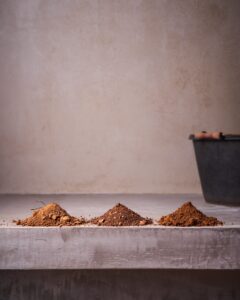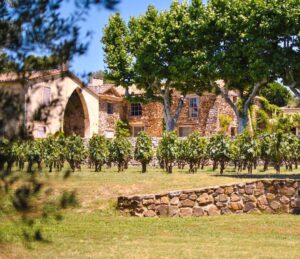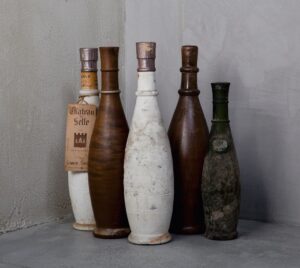The smell of lavender filled the air while an enchanting scene was created by the purple flower spikes accenting tops of green foliage planted throughout the land. The sun, with its golden beams, gave everything a divine light so the olive and mulberry trees glowed and the landscape was further enhanced by the red clay soil adorned with limestone rocks and broken gravel. As shown in the paintings of the greats like Paul Cézanne, Provence, in southeastern France, was stunningly magnificent and even standing there in person, Marcel Ott still couldn’t believe what he was seeing with his own eyes. The picturesque scene was not only unbelievable for its sheer beauty but the fact that many owners were giving the land away almost for free was even more shocking. It seems impossible today that a piece of this French Mediterranean paradise could have been bought for so little, as it is known so well today with many people desperately wanting to win the lottery so they could have their slice of Provence heaven.
In 1896, Marcel Ott had just graduated from an agronomy engineering program in the northeastern French region of Alsace, which borders Switzerland and Germany, so he traveled around France to check out the vineyards in various wine regions. Phylloxera, an insect pest, had already devastated much of Europe, so much so that it is estimated that phylloxera cost France 10 billion francs (back in 1870’s money!). For over a decade, no solution to fix the phylloxera issue could be found and as one can imagine, having one of the most critical sectors of a country’s economy, growing grapes and making wine, taken away with no hope in sight was terrifying. By the end of the 1800s, a solution seemed to be found however, yet it was still risky considering that it would take time to see if phylloxera could truly be defeated, or perhaps another incurable blight could wreak havoc on the vines in the near future.
But Marcel took that gamble and bought his family’s first estate, Château de Selle, in 1912 in the Côtes de Provence, with a mission to elevate rosé wine to an ultra-premium category that would show how this style could express the captivating terroir of Provence. Eventually, his family wines, Domaines Ott, would become world-renowned and open the door for many other premium rosé wines.
Domaines Ott
Over a century later, Marcel’s great-grandson, fourth-generation winemaker Jean-François Ott, oversees their estates and ensures his great-grandfather’s high standard for Provence rosé wines continues to live on with Domaines Ott. The bad image that still lingers on about rosé frustrates Jean-François, such as the misnomer that rosé cannot age, and when the subject is raised, he quickly replies to this misconception by simply saying, “No, a bad wine cannot age.”
One of the things that created a cult following for Domaines Ott rosé wines among fine wine enthusiasts was their ability to express three distinctive terroirs in Provence. The first estate acquired by Marcel was Château de Selle, located in the appellation (designated wine area) called Côtes de Provence, which is situated on high limestone inland slopes with mild winters and dry summers with lots of sunshine. The second, which Marcel and his son acquired in the 1930s, Clos Mireille, also in the Côtes de Provence, overlooks the Mediterranean with the vineyards cooled by the sea’s spray but then warmed by the hillside air. Finally, in 1956, the last estate was acquired in another appellation of Provence called Bandol AOC – less than an hour west of Clos Mireille, named Château Romassan; the wine area of Bandol is unique as it is known for great red wines made mainly from the powerful Mourvèdre red grape variety. Clos Mireille is located in the heart of Bandol, where Mourvèdre does well in the poor, limestone soils that enjoy the extremely dry climate and abundance of sunshine – Bandol is one of the sunniest places in Provence.
Domaines Ott makes an ultra-premium rosé wine from each of these estates, which are bottled separately, to showcase the sense of place of each individual terroir and to display the fine wine ability of Provence rosés. But they also make a small amount of red wine from the Château Romassan and Château de Selle estates as well as a small amount of white wine from the Clos Mireille estate.
Jean-François Ott says that it was a battle through the decades to get people to take rosé wine seriously, and even now, despite the overwhelming popularity of anything pink, he feels in some ways, the popularity itself has hurt the image as the market is mainly saturated with easy to drink, simple rosé wines that limit its image as being a non-serious libation that is best enjoyed when one doesn’t want to overthink what she is drinking. There is undoubtedly a time and place for such wines, but Jean-François is afraid that with its popularity, the idea that there are some rosé wines that are ideal for pairing with an exquisite meal, or ones that can show an incredible depth of complexity after being laid down to cellar, will be lost among the overall rosé wine trend that has been taking the world by storm.
But today, Jean-François is highlighting their commitment to illustrating the high-quality potential of Provence rosé with the stricter selection of their Étoile bottling.
Étoile Rosé
It was important to Jean-François’s great-grandfather to show the world the profound sense of beauty of Provence by capturing the different appellation terroir expressions from three different estates. He also had a vision of giving a sense of the stunning coastline by creating a bottle with curves that Provence itself inspired. Eventually, in the 1930s, Jean-François’s grandfather René Ott settled on the final shape, inspired by ancient Roman amphorae, which were tall, oval-shaped vessels with a narrow cylindrical neck. The shape of the Ott bottle is patented, but other Provence rosé producers have found a way to design a somewhat similar bottle that hints at the Domaines Ott bottle without infringing on the patent. It is still remarkable to think that one of the most iconic wine bottles did not come from a savvy marketing team, but instead, a small multi-generational producer who put everything on the line to bring respect to an underappreciated wine.
And Jean-François has stayed true to his paternal lineage, who has gifted him with some of the most outstanding rosé wines in the world, by keeping the bottle shape, keeping the individual bottlings of each estate and continuing the mission to always seek improvement in the winery and the vineyards by bringing more precision and clarity to the terroir expression.
And so, in 2019, a bottling that blended the portions from each of the three estates was released under the name Étoile which means “star” in French. “My family used to make this cuvée but only for ourselves,” Jean-François noted and he thought the time was right to show the next level of Provence rosé. The Étoile bottling expresses a “deep taste and silky texture” that is balanced by freshness and purity of fruit expression and it brings together all the best attributes of each estate together giving a complete picture of Provence, the place that captivated his great-grandfather all those years ago.
But honoring his lineage goes beyond just keeping the high standards that were first established, he is also determined to continue to push the envelope to keep raising the bar, even if it is by unconventional means. There is nothing odd about some of the changes, including starting the organic certification process (they will be officially certified organic for the 2022 vintage despite already being organic in practice) and aging in spherical ceramic vats for some of the wine for the Étoile bottling as it brings out more “aromatic precision” according to Jean-François. But he is conducting an unorthodox experiment in the vineyards by planting the Italian noble red grape variety Sangiovese on their estates in Provence, France, as he feels that maybe in 15 years it could be needed with rising temperatures due to climate change but time will tell if he does indeed use it in Domaines Ott rosé wines.
Through it all, he still keeps alive what has always been the most important thing to his family: the vineyards. “We spend 600 hours every year per hectare [2.5 acres] working outside,” and the quality comes “100% from the grapes,” noted Jean-François.
A Star Rooted in Humble Beginnings
One could only imagine what Marcel Ott was thinking long ago as a young student risking it all to invest in land that seemed worthless at the time. Did he have any inkling that he would establish one of the greatest rosé wines in the world that was perfectly contained by one of the most iconic bottles in the world? Or was he just taken by the place, knowing he could end up penniless? Even if the French wine industry died at the hands of phylloxera, at least he lived in the closest thing that he could imagine to be heaven.
The one thing that is for certain is that an idealistic young man from humble beginnings was able to break barriers beyond anyone else’s imagination, and today, his high-quality rosé dream has become a standard that many other Provence rosé producers try to live up to yet still none are able to surpass.
2020 Domaines Ott, Étoile Rosé, Vin de France, France: Étoile 2020 is the second vintage of Étoile as 2019 was the inaugural vintage. A blend of 80% Grenache (from Château de Selle and Clos Mireille) and 20% Mourvèdre (Château Romassan). This wine greets the taster with generosity and includes enchanting floral notes of citrus blossom and lavender that has ripe strawberries on the palate with zingy grapefruit and intense stony minerality with marked acidity along the superb length of flavor.
2021 Domaines Ott, Château de Selle, Rosé, Côtes de Provence, France: 55% Grenache, 30% Cinsault, and 10% Mourvèdre and 5% Syrah. At first it invites with savory notes of fresh thyme and rosemary that has mouthwatering acidity on the palate with lemon zest and quince flavors that finishes with wet stones and lots of energy.
2021 Domaines Ott, Clos Mireille, Rosé, Côtes de Provence, France: 70% Grenache, 25% Cinsault and 5% Syrah. A thrilling saline minerality from the first sip with bright acidity balancing the creamy texture with green mango and white peach flavors that has hints of desert scrub, finishing with seashell notes.
2021 Domaines Ott, Château Romassan, Rosé, Bandol, France: 55% Mourvèdre, 30% Cinsault and 15% Grenache. Cherry blossoms and raspberries on the nose intertwined with crushed stones that has a silky texture on the palate with a good amount of flesh mid-palate and has hints of anise on the finish.
2018 Domaines Ott, Clos Mireille, Blanc, Côtes de Provence, France: Blend of Sémillon and Rolle (Vermentino). Oyster shell, sea salt and lemon confit with honeysuckle in the background that evolves with savory notes on the palate such as bay leaf and a hint of white pepper with a creamy texture.
2017 Domaines Ott, Château Romassan, Rouge, Bandol, France: 90% Mourvèdre and 10% Grenache. Multi-layered fruit with black, blue and red berries that are enhanced by chili powder and smoked paprika notes that are grounded in smoldering earth with broad-shouldered tannins, which are well tamed and silky in quality, that are balanced by plush fruit finishing with power and delicious decadence.
















